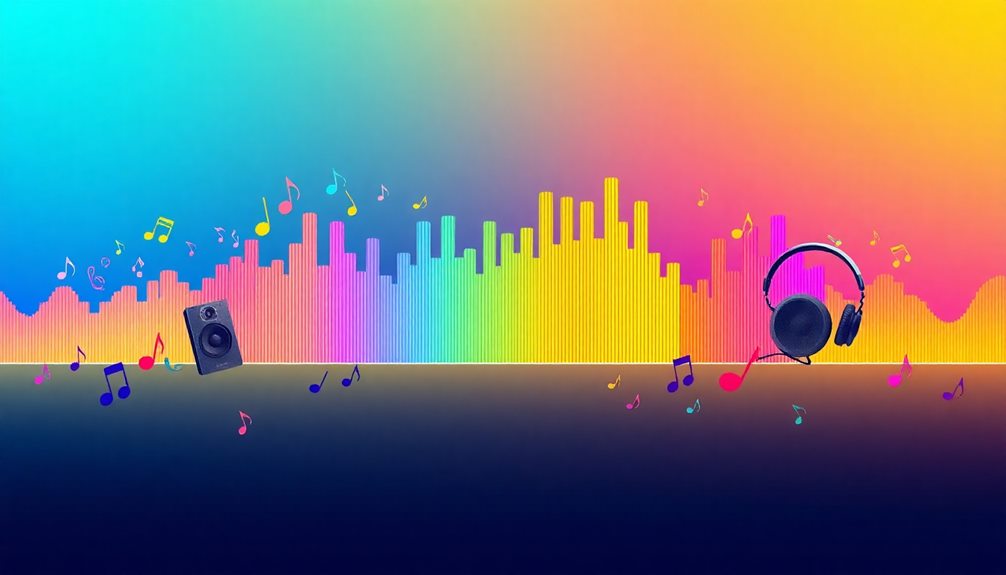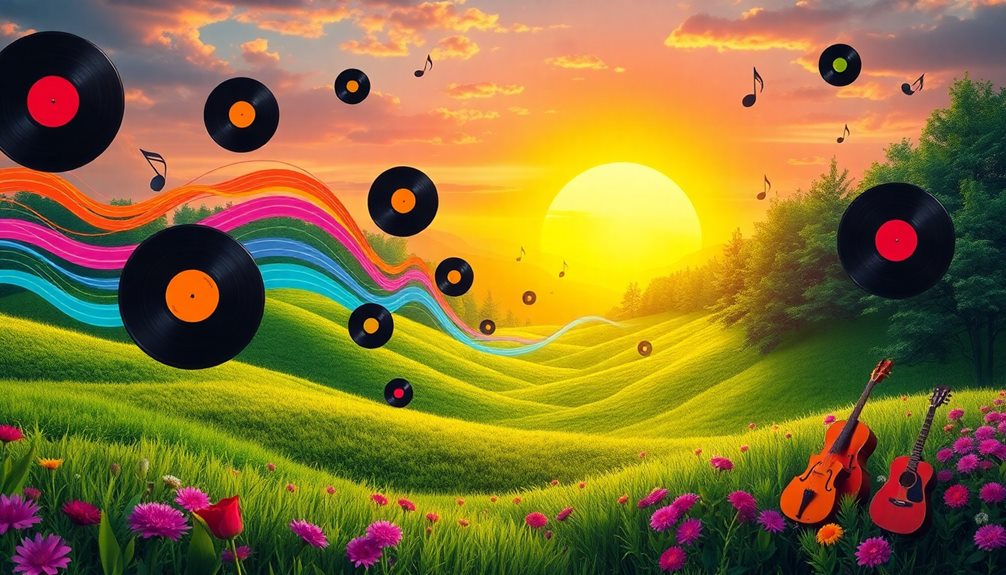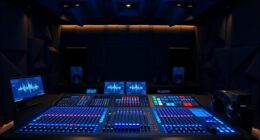Frequency in audio refers to how fast sound waves vibrate, measured in Hertz (Hz). It's what makes music sound different and helps you recognize voices in recordings. The human ear can hear sounds from 20 Hz to 20,000 Hz! Lower frequencies give deep, warm tones, while higher ones add brightness and sparkle. Understanding frequency helps you appreciate how various sounds work together. By manipulating frequency, audio engineers create clearer mixes and emotional experiences in music. It's an exciting journey into sound! Keep exploring, and you'll discover even more fascinating aspects of how audio affects our world.
Key Takeaways
- Frequency, measured in Hertz (Hz), indicates the number of sound wave oscillations per second, impacting pitch perception and audio clarity.
- The audio frequency spectrum ranges from 20 Hz to 20 kHz, with distinct ranges affecting emotional responses in music.
- Equalization (EQ) is used to adjust specific frequencies, enhancing audio quality and ensuring clarity of vocals and instruments.
- Understanding frequency ranges is essential for creating balanced mixes and avoiding clashes between different musical elements.
- Achieving flat frequency response is crucial for accurate sound reproduction, requiring quality monitors and consideration of room acoustics.
Understanding Sound Waves
When you hear a sound, you're experiencing the movement of sound waves through a medium like air. These sound waves are mechanical waves, which means they need something to travel through, like solids, liquids, or gases. As sound waves move, they create oscillations—back-and-forth movements of particles. This creates areas of compression and rarefaction.
Now, let's talk about frequency! Frequency is how many times these oscillations happen in one second, and it's measured in Hertz (Hz). The human hearing range is amazing! You can hear sounds from about 20 Hz to 20,000 Hz (or 20 kHz). Isn't that cool?
Higher frequencies mean shorter wavelengths, which are the distances for one complete cycle of sound. So, when you hear a high-pitched note, it has a higher frequency and a shorter wavelength.
Sound travels through the air at about 343 meters per second, but it can move faster in other materials.
Defining Frequency
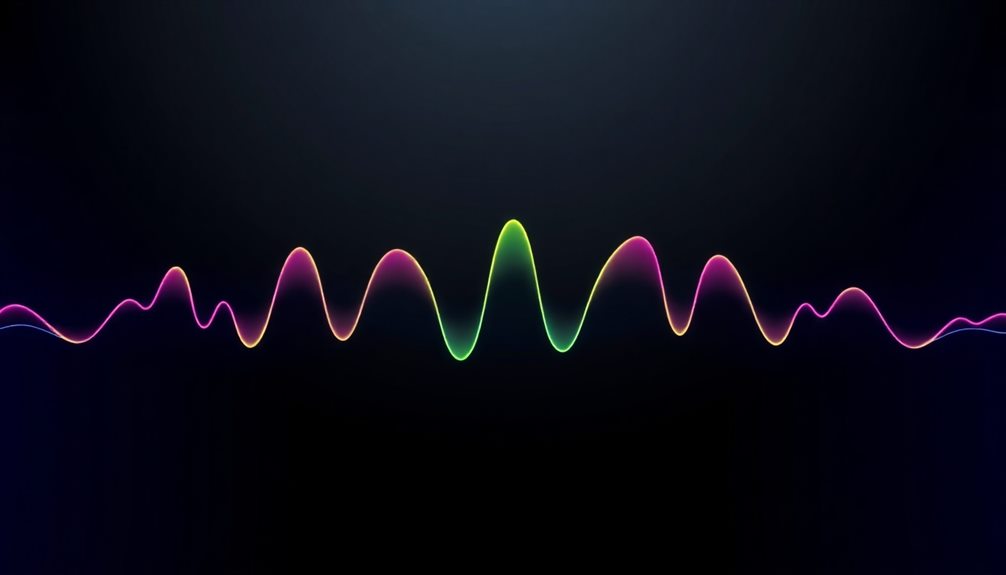
Let's get excited about frequency!
Measured in Hertz (Hz), frequency tells us how many times sound waves vibrate each second. It shapes how we hear music, with different ranges creating deeper or brighter sounds that make our favorite songs come alive!
Frequency Measurement in Hertz
Frequency in audio, measured in Hertz (Hz), defines how many cycles of a sound wave occur each second. This measurement is essential for understanding the audio frequency spectrum and how we perceive sound. The human hearing range typically spans from 20 Hz to 20,000 Hz (20 kHz). Let's break it down a bit!
| Frequency Range | Description | Examples |
|---|---|---|
| 20 Hz – 250 Hz | Low frequencies | Bass guitar, thunder |
| 250 Hz – 2000 Hz | Mid frequencies | Human voice, piano |
| 2000 Hz – 20,000 Hz | High frequencies | Bird chirps, cymbals |
Lower frequencies have longer wavelengths and create deeper sounds, while higher frequencies have shorter wavelengths and result in higher pitches. Understanding frequency measurement in hertz helps you appreciate how different sounds are created and how they affect music or audio you listen to every day. It's exciting to know that by changing the frequencies, we can create different feelings in music! So, immerse yourself in the world of sound, and explore the amazing frequencies that make up the audio you love!
Pitch and Sound Perception
Understanding how frequency influences the perception of sound helps clarify why we experience music and other audio in unique ways.
Pitch is directly linked to frequency. Each note you hear corresponds to a specific frequency in the frequency spectrum. For instance, the note A4 has a frequency of 440 Hz. The human hearing range typically spans from 20 Hz to 20,000 Hz.
Here are some key points about pitch and sound perception:
- Frequency and Pitch: Higher frequencies create higher pitches, while lower frequencies produce lower pitches.
- Harmonics: These are integer multiples of a fundamental frequency, adding richness and depth to sounds, allowing you to tell different instruments apart even when they play the same note.
- Subjectivity of Pitch: Your perception of pitch can change based on age or exposure to loud sounds, affecting how you hear higher frequencies.
- Hearing Limits: Sounds below 20 Hz (infrasonic) and above 20 kHz (ultrasonic) are typically outside the human hearing range.
Exploring these factors can deepen your appreciation for the sounds around you and the music you love!
Frequency Impact on Music
In music, the impact of frequency shapes how you experience sound and emotion. Frequencies are measured in Hertz (Hz), and they range from low to high. Each part of the frequency spectrum plays a special role in music. Low frequencies create warmth, while high frequencies bring brightness. Understanding these differences can make your mixing and mastering much more effective!
Here's a quick look at how different frequencies affect music:
| Frequency Range | Sound Type | Emotional Impact |
|---|---|---|
| 20-60 Hz | Sub-bass | Warmth and depth |
| 60-250 Hz | Bass | Fullness and power |
| 250-2000 Hz | Midrange | Clarity and presence |
| 2000-20,000 Hz | Treble | Brightness and sparkle |
| Above 20,000 Hz | Ultra High | Airiness and excitement |
The Importance of Frequency

Sound's richness and depth are deeply influenced by frequency, which is measured in Hertz (Hz) and signifies the number of cycles per second. Understanding frequency is key to enjoying music and sound. It helps you hear the unique qualities of every audio piece. Here's why frequency matters:
- Frequency Spectrum: It covers a range from 20 Hz to 20 kHz, allowing you to experience everything from deep bass frequencies that give warmth to high treble frequencies that add sparkle.
- Pitch Perception: Different frequencies create specific pitches. Higher frequencies produce higher notes, while lower ones create deeper sounds.
- Emotional Impact: Frequencies can stir emotions. Sub-bass can feel powerful and comforting, while high frequencies can feel bright and uplifting.
- Audio Mixing: Mastering frequency helps in mixing sounds. It guarantees clarity and balance by preventing overlap between bass and treble frequencies.
Frequency Ranges Explained
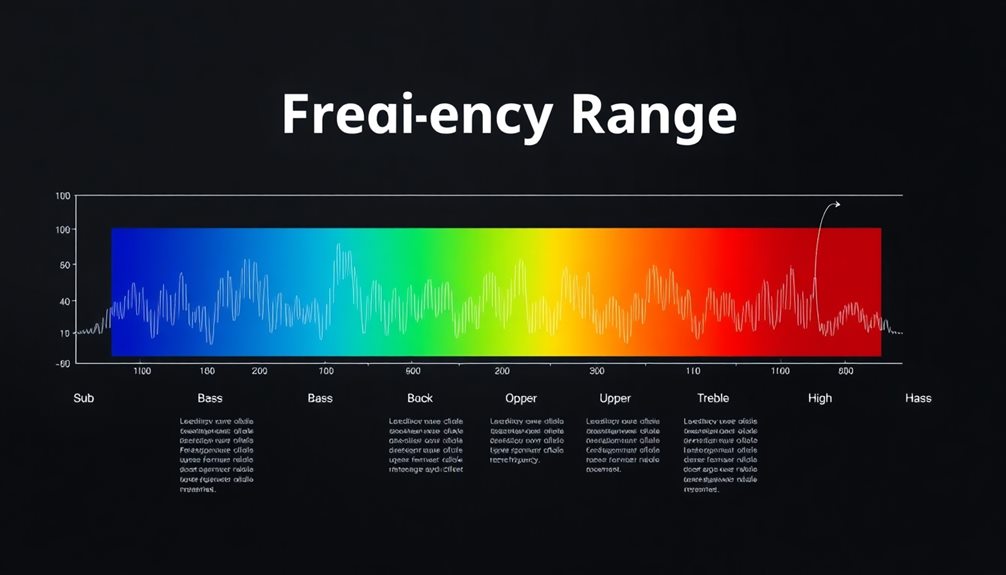
Exploring frequency ranges reveals how each segment plays a distinct role in the audio experience. The human hearing range typically spans from 20 Hz to 20 kHz, which is quite amazing! Let's break it down.
First, we've the Sub-bass (20-60 Hz) providing deep vibrations that you can feel. Then comes Bass (60-250 Hz), which adds warmth to music and gives it that rich sound.
Midrange frequencies (500-2,000 Hz) are super important too, as they help you hear vocals and instruments clearly. As we go higher, we enter the Upper Midrange (2,000-4,000 Hz) and Treble (above 4,000 Hz).
These frequency ranges bring brightness and sparkle to sounds, making them more exciting and detailed. Low frequencies, like bass, are essential for keeping the rhythm, while midrange frequencies guarantee you catch every word in a song.
Understanding these frequency ranges helps you appreciate music better and creates a balanced audio experience. So, next time you listen, pay attention to how these different frequencies come together to create the magic of sound!
Frequency and Pitch Relationship
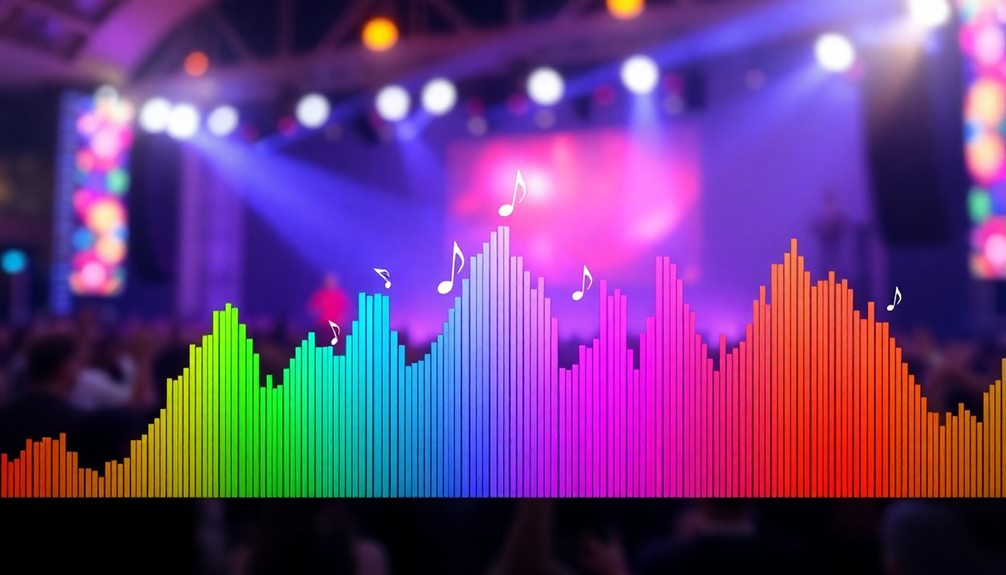
Understanding frequency ranges is just the beginning when it comes to audio. The relationship between frequency and pitch is essential for anyone diving into the world of sound. Frequency, measured in Hertz (Hz), tells you how fast a sound wave vibrates. This vibration directly affects how we perceive pitch. Higher frequencies, like 2000 Hz and above, create higher-pitched sounds, while lower frequencies, such as 20 Hz to 250 Hz, produce lower-pitched sounds.
Here are a few key points to remember about frequency and pitch:
- The human hearing range is from 20 Hz to 20,000 Hz (20 kHz).
- Frequencies below 20 Hz are called infrasonic, and those above 20 kHz are ultrasonic.
- Each musical note has a specific frequency; for example, A above middle C is tuned to 440 Hz.
- Understanding this relationship helps musicians and audio engineers create harmonious sounds.
Role of EQ in Audio
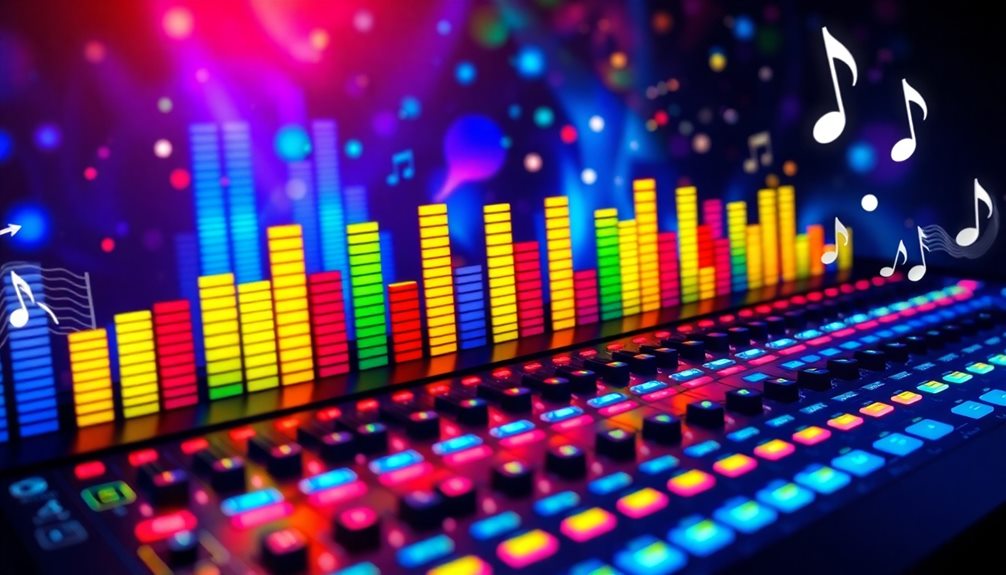
Equalization, or EQ, plays a big role in making audio sound its best!
You can use different types of EQ, like parametric or graphic, to tweak specific frequencies, helping to create a clear and balanced mix.
EQ Types and Functions
In audio production, the role of EQ is essential for crafting a polished sound that resonates with listeners. Equalization (EQ) helps you adjust the balance of different frequency ranges, making your music clearer and more enjoyable.
There are several EQ types, each serving a unique purpose. Here are some key EQ types and their functions:
- Parametric EQ: This allows you to control frequency, bandwidth, and gain precisely. You can sculpt your sound exactly how you want it.
- Graphic EQ: It has fixed frequency bands with sliders, letting you boost or cut ranges easily. This is great for quick adjustments.
- Shelving EQ: This type boosts or cuts frequencies above or below a specified point, perfect for making broad tonal changes.
- High-pass filters: These remove low frequencies to reduce muddiness, enhancing clarity and presence in your mix.
Using EQ effectively helps tackle issues like excessive bass or harsh mids.
Frequency Adjustments and Impact
When you adjust frequencies in your audio mix, you're directly influencing the overall sound quality and listener experience. Equalization (EQ) is your powerful tool for this! It lets you enhance or reduce specific frequency ranges, making your mix shine.
For example, when you boost frequencies between 60 Hz and 250 Hz, you add warmth and depth to your music. Isn't that great?
Now, let's talk about high frequencies. If your mix sounds harsh, try using a low-pass filter to cut those high frequencies above 4 kHz. This can help make the sound smoother and more pleasant.
On the flip side, if your vocals or instruments sound muddy, cutting around 300 Hz can clear things up.
Don't forget about midrange frequencies, either! They're super important for vocal clarity and instrument definition. By making precise frequency adjustments in this range (500 Hz to 2 kHz), you can guarantee that everything sounds just right.
With a well-balanced EQ, you can prevent listener fatigue, keeping your audience engaged and happy.
Frequency Management Techniques

Effective frequency management is essential for achieving a polished and professional sound in audio production. By adjusting the balance of different frequency ranges, you'll enhance clarity and quality in your mixes.
Here are some key techniques to take into account:
- Use EQ Wisely: Boost or cut specific frequencies to shape your sound. For instance, cut low mids around 250 Hz to reduce muddiness, or boost upper mids around 4 kHz for clearer vocals.
- Understand the Frequency Spectrum: Familiarize yourself with the frequency spectrum to identify dominant and missing frequencies. This knowledge helps you make targeted adjustments for a balanced sound.
- Apply High-Pass Filters: These filters can remove unwanted low frequencies that may muddy your mix, ensuring everything sounds clear and vibrant.
- Analyze with Spectrum Analyzers: Regularly checking your audio with spectrum analyzers gives you visual feedback on frequency distribution, making it easier to fine-tune your sound.
Achieving Flat Frequency Response
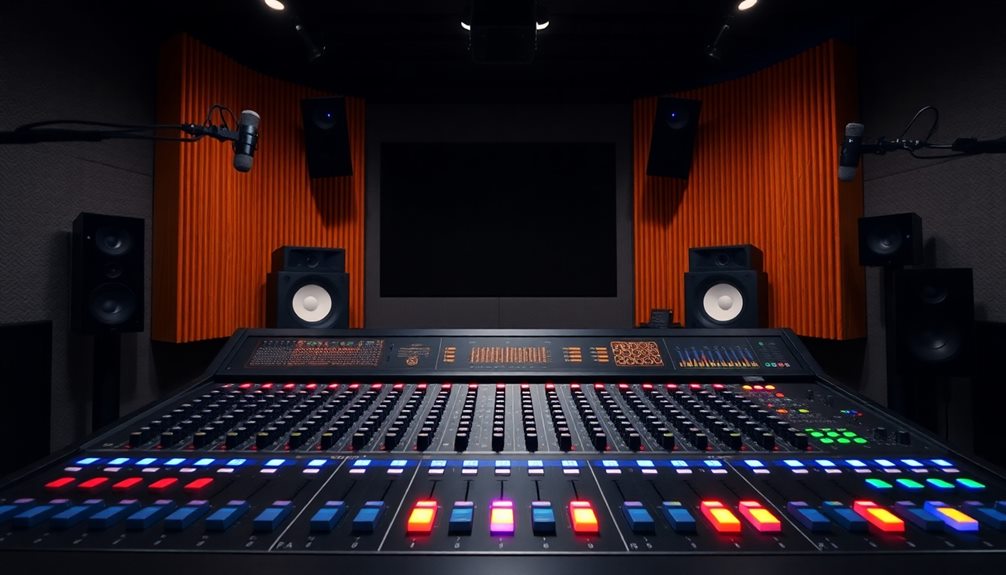
Achieving a flat frequency response is essential for accurate sound mixing and mastering, as it guarantees every frequency is reproduced evenly without any coloration. When you use high-quality studio monitors and headphones, you're on the right track. These tools help you hear sounds clearly across the entire audible range, from 20 Hz to 20 kHz.
Room acoustics play a big role, too! If your room has issues like standing waves or reflections, it can mess with your sound. Consider adding bass traps and diffusers to tackle these problems. They help create a better listening environment, making it easier to attain that flat frequency response you're aiming for.
Monitor placement is another key factor. Position your monitors to form an equilateral triangle with your listening spot. This setup helps assure an accurate representation of sound across all frequencies.
Lastly, don't forget to regularly calibrate your setup using reference microphones. This step can help you find and fix any frequency imbalances in your space, assuring consistent audio quality during production.
With these tips, you'll be well on your way to achieving great sound!
Common Frequency Misconceptions
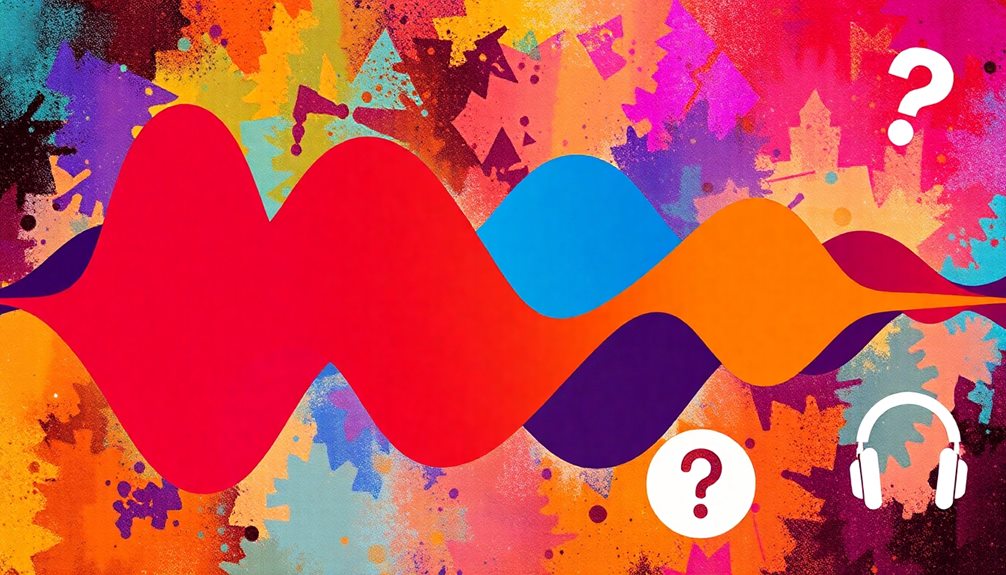
Misunderstandings about frequency can lead to poor audio experiences and subpar mixing results.
It's important to clear up some common misconceptions so you can get the best sound quality possible. Here are four key points to keep in mind:
- Louder is Not Always Better: Increasing volume can distort audio, throwing frequencies out of balance. This can create a muddy sound that's hard to enjoy.
- More Treble Doesn't Mean More Clarity: While treble can add brightness, too much can lead to listener fatigue and harshness, making your mix less enjoyable.
- Low-Quality Speakers Misrepresent Frequencies: They mightn't sound bad; they just struggle to show the true quality of your audio. This can mislead you in your mixing decisions.
- EQ Adjustments Need Care: You can't boost all frequencies equally. Improper EQ can lead to an unbalanced mix, resulting in muddiness that hides the details of your sound.
Practical Applications of Frequency Knowledge

Understanding frequency can really boost your music production skills!
When you know how different sounds fit together, you can make your tracks shine by adjusting the right levels.
Plus, using frequency wisely in sound design helps create amazing audio experiences that can move your listeners emotionally!
Frequency in Music Production
Mastering frequency ranges is vital in music production, as it directly impacts the quality and clarity of your mix. Understanding the different sounds you can create will help you make your music shine.
Here are some key frequency areas to take into account:
- Sub-bass (20-60 Hz): Adds depth and power to your tracks.
- Bass (60-250 Hz): Provides warmth, making your music feel full.
- Midrange (500 Hz – 2 kHz): Essential for vocal clarity and instrument definition.
- Highs (2 kHz and above): Gives brightness and airiness to your sound.
Using equalization (EQ) allows you to boost or cut specific frequency bands, ensuring a balanced mix. It can help reduce muddiness in recordings, making everything sound cleaner.
Different genres focus on different frequencies; for instance, electronic music loves sub-bass, while rock often highlights midrange for vocals and guitars.
Sound Design Techniques
Building on the foundation of frequency ranges in music production, sound design techniques allow you to harness this knowledge to craft unique audio experiences. Understanding the frequency spectrum is key to creating balanced mixes. You can use different frequencies to evoke feelings and enhance your audio storytelling. For example, sub-bass (20-60 Hz) adds depth, while bass (60-250 Hz) brings warmth.
Using EQ, or equalization, is a powerful tool. It lets you boost or cut specific frequency bands, helping to clarify your sounds. If you notice a mix sounding muddy, try adjusting certain frequencies to make each element shine.
Choosing the right instruments is also important. Make sure they fit within desired frequency ranges to avoid clashing sounds.
Experimenting with harmonics and overtones can create richer textures. By playing with different frequency adjustments, you can tap into emotions and tell a story through your music.
Frequently Asked Questions
What Is the Frequency of Audio?
When you ask about audio frequency, you're referring to how many sound wave cycles occur each second. It influences pitch, with higher frequencies creating higher notes and lower frequencies producing deeper, richer sounds in music.
What Is the Meaning of Frequency in Sound?
Frequency in sound refers to how often sound waves oscillate per second. You'll notice that higher frequencies create higher pitches, while lower frequencies produce deeper tones. Understanding this helps you appreciate and manipulate sound more effectively.
What Is 432 Hz Frequency Good For?
Listening to 432 Hz music can enhance your relaxation and emotional well-being. It's believed to resonate with the universe, potentially reducing anxiety and stress while promoting a sense of peace and grounding during meditation.
How Do You Explain Sound Frequency to a Child?
Imagine waves gently rolling on a beach. Sound frequency's like those waves: it counts how many times they rise and fall each second. Higher counts mean higher sounds, like a cheerful whistle or a playful bird!
Conclusion
Now that you've learned about frequency in audio, imagine the sound waves dancing through the air, each frequency creating a unique note. You can hear the sweet melodies and deep bass, making music come alive! Understanding these concepts can help you appreciate your favorite songs even more. So, whether you're mixing tracks or just enjoying a tune, remember that frequency is the heartbeat of sound. Immerse yourself, explore, and let your ears discover the magic of audio!
